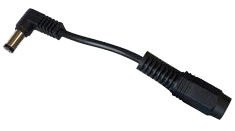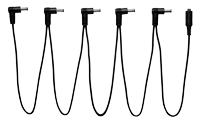In the first part of this series (not that it was ever intended to be a series, but hey…) we looked at a way to use rechargeable LR6/AA batteries as a power source for a small-ish pedalboard daisy chain setup. The idea was to find a cheaper alternative to the Sanyo Pedal Juice, which is simply a large rechargeable 9 volt battery. Off the top of my head, I can think of three main benefits of using a battery rather than wall wart/adapter to provide power:
- Quicker/easier setup, since you won’t have to locate a mains power source reasonably close to where you want to place the pedalboard
- Cleaner power – a battery delivers pure DC, so you won’t have any problems with ripple hum
- No EMF hum – power supplies emit electromagnetic fields, which can cause hum in nearby pedals. Wah pedals are especially sensitive, and even though the higher quality power supplies use toroidal transformers that reduce the EMF size quite considerably, the single wall wart/daisy chain setup the battery rig is rarely that quiet.
So, this is not a replacement for a quality, isolated multi-output supply (like the Voodoo Lab Pedal Power series, Cioks DC8/DC10 etc). Those do things no battery/daisy chain setup can ever do, and do it very well. But if you’re running a daisy chain setup today, going battery might be an option. And for most setups – where you have a few analog pedals and maybe a simple-ish digital delay, with a total current draw of <200mA – the AA batteries setup detailed earlier may serve you well. But this time we will be looking at an option with a little more meat on its bones…
Spoiler option: if you want to see how the setup described below actually worked out for me, scroll to the bottom… also, check out the update. But don’t let that stop you from reading the rest of the post first 🙂
The power source

I came across a discussion thread at The Gear Page, where a poster was wondering if it would be possible to use an emergency power source (meant for mobile phones and tablets) as a cheaper alternative to the Sanyo Pedal Juice. Most USB emergency chargers only output 5 volts, but this particular unit also had a selectable 9/12vDC output.
Basically, it is a 10000mAh (10 amphours) battery with a max load capacity of 2000mA on the 9/12vDC output. As such, it’s quite similar to the Pedal Juice, and at least in this part of the world it’s priced similarly. But this one has the advantage of being able to be used as intended, when not powering the pedalboard 😉 – I quite often find myself needing a top-up charge on the phone or iPad at the end of a long workday.
When I got it home I hooked it up to a Korg G4 leslie simulator. The Korg draws about 290mA, and even though the battery pack was only about 50% charged, it ran the G4 for about 10 hours before shutting down. I actually missed the point where it died, but after about 8 hours running, I measured the voltage at still just above 9 volts DC (the same as it’d been the whole time), which is a good sign. But don’t rush out to buy one just yet – and if you’ve already done so, do not hook it up to your pedals before reading the rest of the article…
Important info and possible deal-breakers
First, the 9/12vDC output is center positive, rather than center negative. This means that the DC cable supplied with the unit will be the wrong polarity for most guitar pedals. To hook it up to any pedals, you need to first reverse the polarity. You can use a special converter cable (if you have a Power-All or 1spot kit, there should be one included, or you can buy them separately) between the cable from the power source and the daisy chain, to make all the plugs center negative. If you don’t adapt the polarity so it is correct for your pedals, you may damage them!
The major difference between the Pedal Juice and this unit is that this is designed to be a mobile phone/tablet/digital camera etc charger. This is a bonus if you plan on using it on a pedalboard that doesn’t see daily use, and have mobile units that from time to time need extra power during the day. But this dual function is also the cause of a possible deal-breaker, in regards to its possible use as a pedalboard power supply. The unit needs to see a certain amount of current draw to stay on – enough to fool it into thinking it’s actually charging something. If the current draw is too small, it will simply shut down. Using a daisy chain to try various combinations of pedals, I was able to determine that the total current draw must be 60mA or more, for it to work. 54mA didn’t keep it on, while adding a 5mA compressor (taking the total to 59mA) did. So if your setup draws below 60mA, you can’t use this battery pack. Either that, or you need to buy more pedals 🙂
How to use it
First off – before even buying it – calculate the total current draw of the pedals you will be powering from it. You can use the power list right here, and simply add together the figures. Make sure the total is above the required current draw to keep the power pack running (which for my unit turned out to be roughly 60mA), so you know you can use it at all.

Then get a reverse polarity converter cable (the Visual Sound L6 Converter or MC5 Reverse Polarity Converter works, or you can make your own). You can use the supplied DC cable to go from the power pack to the converter cable – that way, you’ll end up with a male center negative plug. Important note: This assumes that your supply is the same as mine, with 9v+ on the center pin of the output jack. Make sure you know how the output jack on your particular supply is wired – if it is center negative, you don’t need (and shouldn’t use) any converter.

From there, you can connect to your daisy chain – the male plug at the end of the converter is now the same as the male plug from the wall wart you would otherwise have used.
The same rules apply as with any other daisy chain setup – all pedals need to be normal negative ground (no PNP fuzz pedals) and normal 9vDC powered (no 18vDC or 9vAC pedals). And while the battery will probably be quieter than the equivalent wall wart (due to the lack of ripple and EMF), ground loop hum can still occur, and some pedals simply don’t like being daisy-chained. So it might not work 100% quietly for everyone (um, see below…).
So, did it work?
Sort of. It powered my Korg G4 leslie simulator cleanly and quietly, as it should (it’s battery power, after all). But when I tried a daisy chain cable to power my small board (5 pedals), I got a lot more hiss than expected. Most of it was from the delay pedal, which didn’t hiss when I used the Cioks Baby power supply I was looking to replace… which is weird, because the Baby is also a common ground/daisy chain type setup, so if it were just the daisy-chaining, the hiss should have been the same. To my ears, it also sounded like the power wasn’t completely steady, as the volume would fluctuate ever so slightly. Now, that could have been the switching jacks in the amp’s effects loop acting up (they did so a little later, all on their own, so I will eventually have to go in and re-tension them). So that particular problem probably had nothing to do with the power pack. But the hiss was enough to put me off using it for that setup. It might work perfectly for you – and I might still use it with the G4, to avoid having to muck about with an additional power supply for it. But it didn’t work out for me as I’d wanted, so it’s a no go 🙁 I ordered a Cioks DC8 for this pedalboard instead – I probably should have done that from the get-go, but hey… you pay, you learn, as they say 😉
Update dec 2017: I just spotted the 529 Power Supply from Mission, which is USB-powered. This means you can power it from a normal USB adapter, and of course – which is relevant to this article – a power pack. That may be a better option than using the power pack directly, as I tried above. I haven’t tried the unit, but you can check it out at www.missionengineering.com.